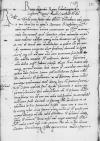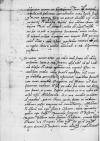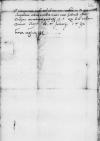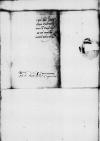Pollicebatur nobis saepius S(trenuitas) or S(inceritas)⌈S(trenuitas)S(trenuitas) or S(inceritas)⌉
Tua litteris suis se apud ⌊sacram caesaream et catholicam maiestatem⌋ nobis impetraturam summam pecuniarum per illustrissimam ⌊matrem nostram⌋ bonae memoriae apud ⌊comitissam Aliani⌋ commodato acceptam, cuius medietas, videlicet quinque milia ducatorum, ad ⌊Ligium Ma text damaged⌈[a]a text damaged⌉rre de Barulo⌋ iure devoluta sunt, a quibus illi pro interesse quotannis quingentos ducatos pendimus, dummodo is Ligius Marre atque alii, ad quos alia pars pecuniarum huiusmodi spectat, rebelles comperti et condemnati fuerint. Habuimus istis diebus magnifici ⌊Ludovici Aliphii⌋, regii et nostri oratoris, aliorumque agentium nostrorum litteras, datas III Novembris anni elapsi, quibus nobis scribunt ⌊Ligium⌋ per commissarios ⌊caesaris⌋ rebellem iudicatum et declaratum ac ad solutionem decem milium ducatorum condemnatum esse bonaque sua et fratrum suorum fisco caesaris applicata sunt [ad] beneplacitum [cae]saris on the margin⌈ad hidden by binding⌈[ad]ad hidden by binding⌉ beneplacitum cae hidden by binding⌈[cae]cae hidden by binding⌉saris[ad] beneplacitum [cae]saris on the margin⌉. Quare hortamur S(trenuitatem) or S(inceritatem)⌈S(trenuitatem)S(trenuitatem) or S(inceritatem)⌉
Tuam cupientes plurimum, sicut nobis pollicita est et ⌊caesaream maiestatem⌋ scripserat S(trenuitas) or S(inceritas)⌈S(trenuitas)S(trenuitas) or S(inceritas)⌉ Tua ad eam rem nobis indulgendam seu concedendam inclinatam fuisse, dummodo, ut diximus, ⌊iste bonus vir⌋ in eo rebellionis crimine sententiatus fuisset. Nunc iam S(trenuitas) or S(inceritas)⌈S(trenuitas)S(trenuitas) or S(inceritas)⌉ Tua velis remisque instet, ut ea summa quinque milium et pensio quingentorum ducatorum ab illa nobis dimittatur et deleatur nosque li paper damaged⌈[li]li paper damaged⌉berae et immunes simus. Nihil inde vergit incommodi ⌊illius maiestati⌋, nobis autem vehementer gratum erit, ubi in hoc benevolentiam liberalitatemque caesaris cognoverimus. Dabit insuper S(trenuitas) or S(inceritas)⌈S(trenuitas)S(trenuitas) or S(inceritas)⌉ Tua
 BCz, 3465, p. 212
diligentem operam, ut et dohanam ⌊Trani⌋ vel superinscribed in place of crossed-out et⌈etvelvel superinscribed in place of crossed-out et⌉ ⌊Monopoli⌋ singulis annis habeamus, quemadmodum antea saepius scripsimus hidden by binding⌈[mus]mus hidden by binding⌉, quod si vero utrumque fieri non poterit, dimissio scilicet summae hidden by binding⌈[ae]ae hidden by binding⌉ memoratae et concessio dohanae, fiat alterum istorum, videlicet hidden by binding⌈[elicet]elicet hidden by binding⌉ dohana Trani vel Monopoli; melius est aliquid nihilo. Res haec, utpote in comparatione servitiorum nostrorum multorum et triginta milium ducatorum auri tempore belli pro necessitate ⌊illius sacrae maiestatis caesareae⌋ expositorum, minima est, parvo negotio obtineri poterit, dummodo S(trenuitas) or S(inceritas)⌈S(trenuitas)S(trenuitas) or S(inceritas)⌉ Tua diligentiam praestiterit.
BCz, 3465, p. 212
diligentem operam, ut et dohanam ⌊Trani⌋ vel superinscribed in place of crossed-out et⌈etvelvel superinscribed in place of crossed-out et⌉ ⌊Monopoli⌋ singulis annis habeamus, quemadmodum antea saepius scripsimus hidden by binding⌈[mus]mus hidden by binding⌉, quod si vero utrumque fieri non poterit, dimissio scilicet summae hidden by binding⌈[ae]ae hidden by binding⌉ memoratae et concessio dohanae, fiat alterum istorum, videlicet hidden by binding⌈[elicet]elicet hidden by binding⌉ dohana Trani vel Monopoli; melius est aliquid nihilo. Res haec, utpote in comparatione servitiorum nostrorum multorum et triginta milium ducatorum auri tempore belli pro necessitate ⌊illius sacrae maiestatis caesareae⌋ expositorum, minima est, parvo negotio obtineri poterit, dummodo S(trenuitas) or S(inceritas)⌈S(trenuitas)S(trenuitas) or S(inceritas)⌉ Tua diligentiam praestiterit.
Ne autem ⌊Montis Serici⌋, qui nobis cordi semper est, oblitae censeamur, sciat S(trenuitas) or S(inceritas)⌈S(trenuitas)S(trenuitas) or S(inceritas)⌉ Tua scriptum nobis esse ab ipso ⌊Ludovico Aliphio⌋ et ceteris agentibus nostris negotium ipsum in conclusione pendere iamque fuisset conclusum, nisi unus ex iudicibus commissariis infirmitate impeditus fuisset, iam tamen convaluit et negotium vel finitum, vel brevi finiturum credimus et sive pro nobis, sive contra nos decretum fuerit, in gratia ⌊caesaris⌋, pluries ea in re nobis promissa, nihil addubitamus et S(trenuitas) or S(inceritas)⌈S(trenuitas)S(trenuitas) or S(inceritas)⌉ Tua curabit quantocius id expedire. Poterit etiam aperta fronte in medium adducere, praeter sanguinis nostri coniunctionem, affectum et officia nostra erga ⌊illius sacram caesaream maiestatem⌋, speciatim a written over q⌈qaa written over q⌉utem erga serenissimum ⌊Romanorum, Hungariae et Bohemiae regem⌋, fratrem nostrum honorandum et affinem, quanto studio et amore res et negotia illius serenitatis hic apu paper damaged⌈[u]u paper damaged⌉d serenissimum ⌊regem⌋, dominum et consortem nostrum colendissimum, a paper damaged⌈[a]a paper damaged⌉mplectimur
 BCz, 3465, p. 213
et promovemus, unde vel ob eam rem nostri in ⌊regno Neapolitano⌋ ceteris omnibus maior ratio habenda esset. Reliqua committimus prudentiae S(trenuitatis) or S(inceritatis)⌈S(trenuitatis)S(trenuitatis) or S(inceritatis)⌉
Tuae, quae bene valeat.
BCz, 3465, p. 213
et promovemus, unde vel ob eam rem nostri in ⌊regno Neapolitano⌋ ceteris omnibus maior ratio habenda esset. Reliqua committimus prudentiae S(trenuitatis) or S(inceritatis)⌈S(trenuitatis)S(trenuitatis) or S(inceritatis)⌉
Tuae, quae bene valeat.
 BCz, 3465, p. 212
diligentem operam, ut et dohanam
BCz, 3465, p. 212
diligentem operam, ut et dohanam  BCz, 3465, p. 213
et promovemus, unde vel ob eam rem nostri in
BCz, 3465, p. 213
et promovemus, unde vel ob eam rem nostri in 


